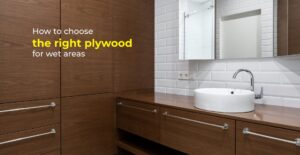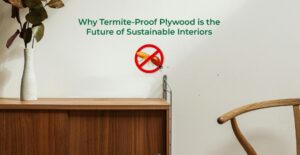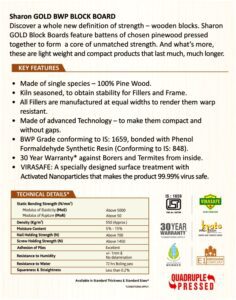

In today’s world, where environmental consciousness is at an all-time high, people are becoming increasingly mindful of their choices, from the food they consume to the materials used in construction and furniture. Growing consumer demand for environmentally friendly plywood is a major change in the construction and manufacturing sectors. As consumers and companies alike strive to reduce their carbon footprint, the use of sustainable materials is not just a trend, but it’s a movement. Let’s explore the trends driving the interest in eco-friendly plywood and why it is essential to embrace these green choices.
Table of contents
What is Eco-friendly Plywood?
Why is There a Rising Interest in Eco-friendly Plywood?
Key Trends in Eco-friendly Plywood
How to Identify Authentic Eco-friendly Plywood
The Future of Eco-friendly Plywood
A Step towards a Sustainable Future: Eco-friendly Plywood
Eco-friendly plywood refers to a type of plywood produced with minimal environmental impact. It is manufactured using sustainable materials, such as wood sourced from responsibly managed forests, and bonded together using non-toxic, low-emission adhesives. Unlike traditional plywood, which may contain harmful chemicals like formaldehyde, eco-friendly plywood is designed to be safer for both the environment and the people who use it.
This type of plywood is not only durable and versatile, but it also aligns with the growing consumer demand for products that support a greener planet. The benefits of this plywood extend beyond environmental advantages, making it an attractive choice for both commercial and residential projects.
The shift toward eco-friendly products is driven by increasing awareness of environmental degradation and climate change. As industries expand, they contribute to deforestation, carbon emissions, and the depletion of natural resources. By opting for sustainable materials like eco-friendly plywood, individuals and businesses can minimise their environmental impact.
Traditional plywood often contains volatile organic compounds (VOCs) that can off-gas harmful chemicals, posing risks to human health. One prevalent component, formaldehyde, has been connected to respiratory problems as well as more serious medical concerns. In contrast, eco-friendly plywood is made with low-VOC or zero-emission adhesives, reducing indoor air pollution and creating a healthier environment for families and businesses concerned about air quality.
The construction industry is notorious for its environmental footprint, but this is changing with the rising demand for sustainable building materials. Eco-friendly plywood contributes to greener construction practices. It is often made from fast-growing, renewable wood species, reducing the need for logging old-growth forests. Additionally, production processes are designed to minimise waste and energy consumption.
A vital aspect of this plywood is its role in reducing emissions. Zero emission plywood is made without harmful chemicals and does not release toxic gases. This type of plywood is crafted using advanced manufacturing technologies that eliminate harmful off-gassing. It is increasingly popular among builders and consumers committed to green practices and improving indoor air quality. It also helps builders meet strict environmental certifications, such as LEED (Leadership in Energy and Environmental Design).
As the demand for eco-friendly plywood grows, so does the importance of verifying its environmental credentials. Certification programs such as the Forest Stewardship Council (FSC) and Green Guard ensure that plywood products meet strict sustainability standards. These certifications provide consumers with confidence that they are making genuinely eco-friendly choices.
One of the latest trends in sustainable materials is the rise of zero emission plywood. With increased focus on air quality, this type of plywood is in high demand for both residential and commercial projects. Manufacturers are developing innovative adhesives and techniques to create plywood that emits no harmful chemicals during its life cycle, particularly in spaces like schools and hospitals where air quality is critical.
Another emerging trend is the development of biodegradable and fully recyclable plywood options. Unlike traditional plywood, which can take years to decompose, eco-friendly alternatives are designed to break down quickly without releasing harmful substances. Some forms of eco-friendly plywood can also be easily recycled, ensuring a longer life cycle and reducing the demand for new raw materials.
Reclaimed wood is increasingly used to produce eco-friendly plywood. Wood salvaged from old buildings or industrial facilities is repurposed to create high-quality plywood products. This trend reduces the demand for virgin wood and helps combat deforestation. The unique grain patterns and history of reclaimed wood also appeal to architects and designers looking to create eco-conscious yet visually appealing interiors.
As eco-friendly plywood gains popularity, manufacturers are offering a greater range of design options and customisation. This allows architects, builders, and homeowners to incorporate sustainable materials into their projects without compromising aesthetics. Whether it’s sleek, modern finishes or rustic, natural designs, these plywood can be tailored to meet various preferences, making it versatile for diverse applications.
With the growing popularity of sustainable materials, it’s crucial to ensure the plywood you purchase is genuinely eco-friendly. Here are some tips for identifying authentic eco-friendly plywood:
Look for FSC or other recognised sustainability certifications that verify responsible sourcing and minimal environmental impact.
Reputable manufacturers will provide detailed information about their production processes and the environmental benefits of their products.
Check for labels indicating low VOC content, zero-emission plywood, or the use of non-toxic adhesives.
Ensure the wood is sourced from managed forests or contains reclaimed or recycled materials.
As environmental regulations tighten and consumer preferences shift toward sustainability, the future of eco-friendly plywood looks promising. The combination of zero emission plywood, sustainable production methods, and recyclable options ensures that plywood will remain a vital material in construction. As technological advancements continue, we can expect even more innovative solutions that enhance the durability, versatility, and eco-friendliness of plywood.
In conclusion, eco-friendly plywood is more than just a trend—it’s a critical part of the green building movement. With its ability to reduce harmful emissions, support sustainable forestry, and offer health benefits, it’s no wonder that eco-friendly plywood is gaining popularity. Whether you are renovating your home or working on a large-scale commercial project, choosing eco-friendly plywood is a step toward a more sustainable future. For those looking for quality options, SharonPly offers a range of products that reflect this commitment to sustainability.










Users understand that SHARONPLY is committed to protecting the User’s privacy and shall take all efforts to protect any personal data provided to the Website by reasonable security safeguards against such risks as loss or unauthorised use, destruction, modification or disclosure of data, However, in case of any lapse, SHARONPLY shall not be held responsible for any effect or consequences thereof. The Website uses cookies to track usage of the path of the User. Since most web browsers automatically accept cookies, User can edit User’s browser options to block them if User does not want the Website to use cookies to track usage of the path of the User.
SHARONPLY undertakes not to disclose, except as otherwise provided, the personal information provided by the User to any person, unless such action is necessary to: –
By filling up any form on the Website User automatically grants SHARONPLY a royalty-free, perpetual, irrevocable non-exclusive license to use, reproduce, publish, edit, distribute, and publicly display the information given in the form and to sublicense such rights.
Any queries regarding the SHARONPLY’s privacy policy, may be sent to admin@sharonply.com.

